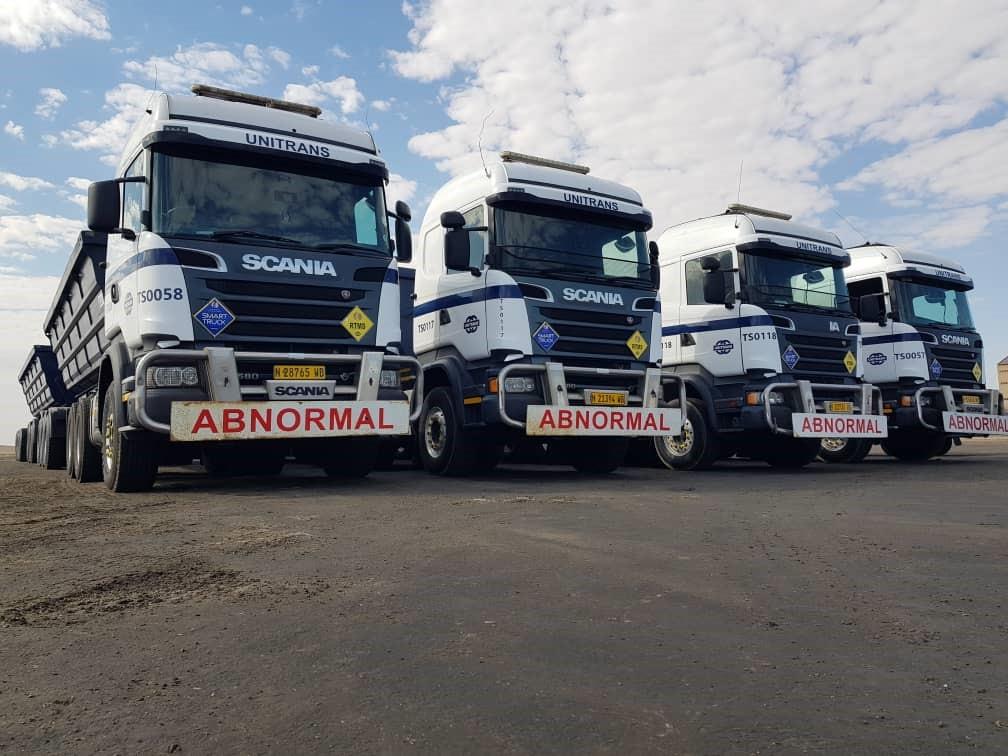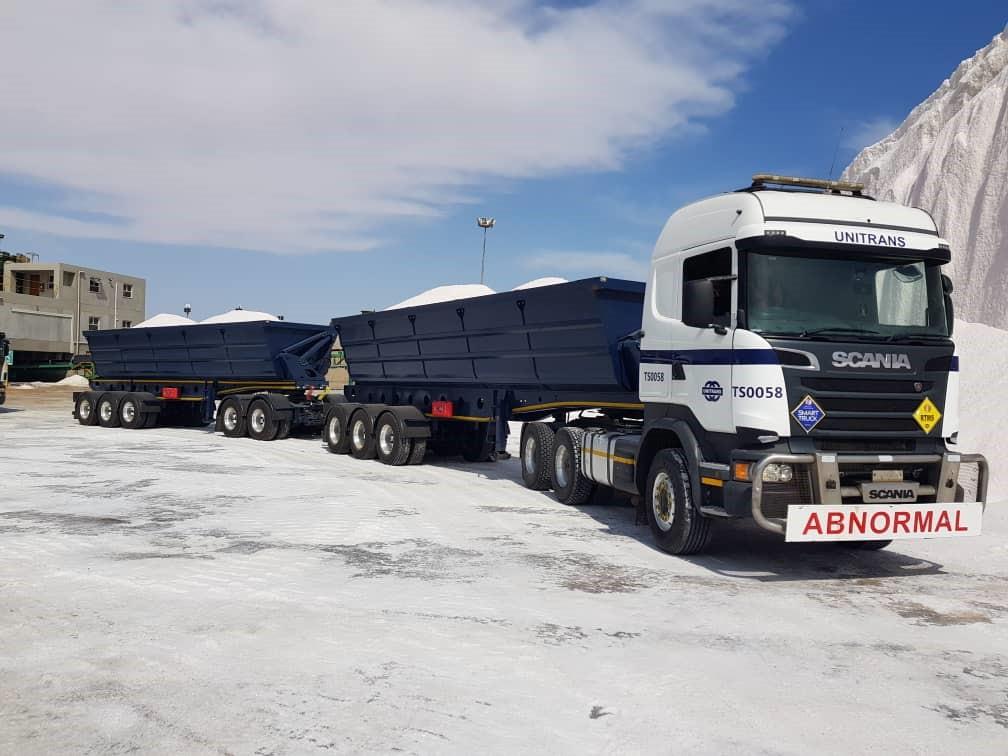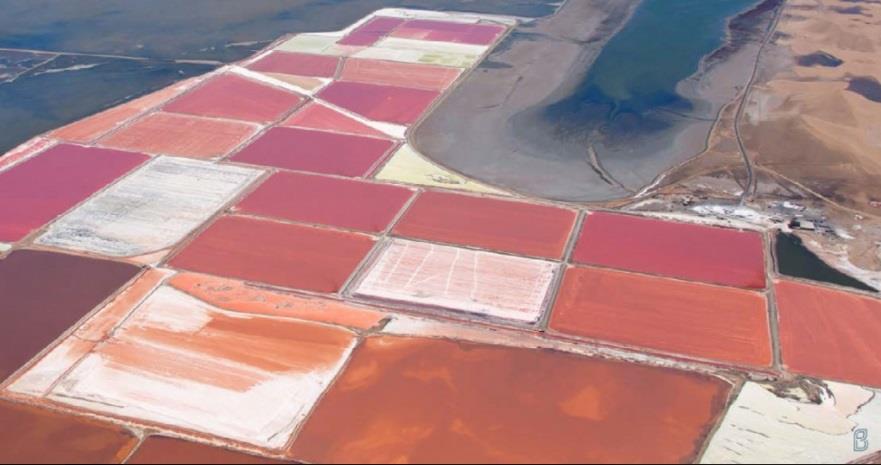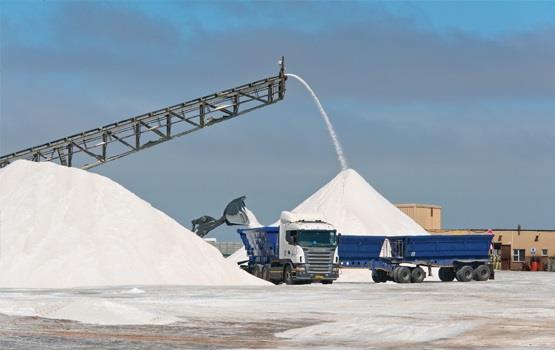Steady improvement on salt mining
Walvis Bay Salt Holdings on a quest to improve services
Leandrea Louw
WALVIS BAY
Walvis Bay Salt Holdings (Pty) Ltd is the largest producer of solar sea salt in sub-Saharan Africa and is Africa’s biggest salt mine.
Established in 1964, the group is a Namibian registered company consisting of three subsidiaries.
The salt field’s current capacity is in excess of 900 000 tonnes per annum, dependent on evaporation rates. The business is currently going through exciting times and the new focus is on value addition, both locally and internationally.
One of these improvements to business operations is that Walvis Bay Salt has partnered with Unitrans Namibia to introduce new Performance Based Standards (PBS) vehicles, or smart trucks, to move salt from its processing plant south of Walvis Bay to the port. The new PBS vehicles became officially operational in July.
Annually, the company transports about 600 000 tons of processed product to the port of Walvis Bay for exports to international markets. The new fleet of four PBS vehicles will replace the previous fleet of 10 Interlink trucks, reducing the daily number of trips by nearly half to less than 50.
According to Walvis Bay Salt Holdings’ managing director Andre Snyman, the introduction of the new vehicles is aimed at promoting safety, innovation and efficiency in transport.
“Together with Unitrans Namibia, we are the first company on the continent that has embraced this new A – double PBS transport technology; now we are bringing this to Walvis Bay.”
The new trucks were designed and built by AFRIT in South Africa, a BUD Group sister company of Walvis Bay Salt, and boasts a payload of 64 tonnes compared to the 34 tonones of the current Interlink trucks. They are slightly longer at 27 metres, compared to the 22 metres of the current trucks.
In total, five new trucks will be introduced.
Apart from a drastic reduction in the number of daily trips, the new A-Double Side Tipper trucks also offer various other benefits including less load-bearing on the road, better turning, less spilling, and a higher rollover stability.
During January, Walvis Bay Salt sponsored the upgrade of the road surface at the intersection of Nangolo Mbumba Drive and 5th Road with a brick surface as part of a public-private partnership with the municipality of Walvis Bay.
The PBS project was undertaken in partnership with Unitrans Namibia, the long-standing logistics partner of Walvis Bay Salt. The Roads Authority of Namibia and the local Walvis Bay municipality have granted the necessary approvals to operate the vehicles on the same route as is currently being used.
Salt export
Additionally, the Namibia Ports Authority (Namport) recorded an increase in salt exports during August 2021.
Two vessels were recently docked to load salt destined for the Democratic Republic of Congo. The Maria Da Paz loaded 4 500 metric tons of bagged salt, while the Uniscout loaded 7 000 metric tons of bagged salt, and is destined for the Port of Matadi.
Over the past four months, Namport recorded a combined total (bagged and bulk salt) of 160 186 metric tons of salt exported via the port of Walvis Bay to various destinations.
There was a significant increase as from April to July 2020, a total of 140 044 tonnage of salt was exported, while 160 186 was exported from April to July 2021.
Process
Walvis Bay Salt’s production process is based on the solar evaporation of seawater to produce 99.4% pure sodium chloride (NaCl) on dry mass basis. Seawater, which is the only raw material, contains a 3.5% concentration of salt, of which 2.9% is sodium chloride. The water is pumped from a natural lagoon into a series of pre-evaporation ponds and then through a series of concentration ponds. The total operation covers an area of 4 500 hectares.
Stimulated by wind and sun, the brine salinity (concentrated salt water) content gradually increases until it reaches 25% NaCl, at which point it is pumped into crystallisation ponds, each with a surface area of about 20 hectares. The salt then crystallises to form a layer of crystals on the various crystalliser pavements.
During the evaporation process, brine depths and densities are controlled to ensure that the maximum number of unwanted chemical impurities are precipitated before they enter the crystallisers. A similar monitoring programme is adopted to control the depth and density of crystallisation ponds to achieve optimum efficiency levels. Performance is constantly monitored by technicians at an on-site laboratory.
Once the salt crystals have grown to the required levels, the product is removed by mechanical harvesters and transported to a processing plant. Here, the raw product undergoes a process of upgrading, using dilute brine as a washing medium. During the wash process, impurities including calcium, sulphate and magnesium are removed. Finally, the processed salt is dried through centrifuges and stockpiled.
Salt is required by customers in a variety of different bag sizes, and is packed at a food-grade bagging facility. Specific package identification and granule sizes are incorporated during this process according to customer needs.
Product destined for bulk exports is transported from the bulk storage facility at the harbour by a conveyor belt and spout-trimmed into the ship’s hold at the Walvis Bay harbor dockside. Loading can take place on a 24-hour basis, seven days a week. Bulk product is shipped to southern Africa, West and East Africa, as well as Europe and North America.
Passion
“The company’s achievements also flow from our passion for continued development of our human capital, ongoing respect for the delicate natural environment and consideration of the interests and well-being of our community in which we operate.”
In the salt industry, efficiency of freight and transport are essential for success. Thus, Walvis Bay Salt is focused on optimising the logistics value chain, including finding the right freight options that can open up new markets.
The company celebrated its 50-year anniversary in 2014. On the back of continuous improvement, the company is looking forward to maintaining momentum with regards to future growth, in a sustainable and environmentally responsible way.
WALVIS BAY
Walvis Bay Salt Holdings (Pty) Ltd is the largest producer of solar sea salt in sub-Saharan Africa and is Africa’s biggest salt mine.
Established in 1964, the group is a Namibian registered company consisting of three subsidiaries.
The salt field’s current capacity is in excess of 900 000 tonnes per annum, dependent on evaporation rates. The business is currently going through exciting times and the new focus is on value addition, both locally and internationally.
One of these improvements to business operations is that Walvis Bay Salt has partnered with Unitrans Namibia to introduce new Performance Based Standards (PBS) vehicles, or smart trucks, to move salt from its processing plant south of Walvis Bay to the port. The new PBS vehicles became officially operational in July.
Annually, the company transports about 600 000 tons of processed product to the port of Walvis Bay for exports to international markets. The new fleet of four PBS vehicles will replace the previous fleet of 10 Interlink trucks, reducing the daily number of trips by nearly half to less than 50.
According to Walvis Bay Salt Holdings’ managing director Andre Snyman, the introduction of the new vehicles is aimed at promoting safety, innovation and efficiency in transport.
“Together with Unitrans Namibia, we are the first company on the continent that has embraced this new A – double PBS transport technology; now we are bringing this to Walvis Bay.”
The new trucks were designed and built by AFRIT in South Africa, a BUD Group sister company of Walvis Bay Salt, and boasts a payload of 64 tonnes compared to the 34 tonones of the current Interlink trucks. They are slightly longer at 27 metres, compared to the 22 metres of the current trucks.
In total, five new trucks will be introduced.
Apart from a drastic reduction in the number of daily trips, the new A-Double Side Tipper trucks also offer various other benefits including less load-bearing on the road, better turning, less spilling, and a higher rollover stability.
During January, Walvis Bay Salt sponsored the upgrade of the road surface at the intersection of Nangolo Mbumba Drive and 5th Road with a brick surface as part of a public-private partnership with the municipality of Walvis Bay.
The PBS project was undertaken in partnership with Unitrans Namibia, the long-standing logistics partner of Walvis Bay Salt. The Roads Authority of Namibia and the local Walvis Bay municipality have granted the necessary approvals to operate the vehicles on the same route as is currently being used.
Salt export
Additionally, the Namibia Ports Authority (Namport) recorded an increase in salt exports during August 2021.
Two vessels were recently docked to load salt destined for the Democratic Republic of Congo. The Maria Da Paz loaded 4 500 metric tons of bagged salt, while the Uniscout loaded 7 000 metric tons of bagged salt, and is destined for the Port of Matadi.
Over the past four months, Namport recorded a combined total (bagged and bulk salt) of 160 186 metric tons of salt exported via the port of Walvis Bay to various destinations.
There was a significant increase as from April to July 2020, a total of 140 044 tonnage of salt was exported, while 160 186 was exported from April to July 2021.
Process
Walvis Bay Salt’s production process is based on the solar evaporation of seawater to produce 99.4% pure sodium chloride (NaCl) on dry mass basis. Seawater, which is the only raw material, contains a 3.5% concentration of salt, of which 2.9% is sodium chloride. The water is pumped from a natural lagoon into a series of pre-evaporation ponds and then through a series of concentration ponds. The total operation covers an area of 4 500 hectares.
Stimulated by wind and sun, the brine salinity (concentrated salt water) content gradually increases until it reaches 25% NaCl, at which point it is pumped into crystallisation ponds, each with a surface area of about 20 hectares. The salt then crystallises to form a layer of crystals on the various crystalliser pavements.
During the evaporation process, brine depths and densities are controlled to ensure that the maximum number of unwanted chemical impurities are precipitated before they enter the crystallisers. A similar monitoring programme is adopted to control the depth and density of crystallisation ponds to achieve optimum efficiency levels. Performance is constantly monitored by technicians at an on-site laboratory.
Once the salt crystals have grown to the required levels, the product is removed by mechanical harvesters and transported to a processing plant. Here, the raw product undergoes a process of upgrading, using dilute brine as a washing medium. During the wash process, impurities including calcium, sulphate and magnesium are removed. Finally, the processed salt is dried through centrifuges and stockpiled.
Salt is required by customers in a variety of different bag sizes, and is packed at a food-grade bagging facility. Specific package identification and granule sizes are incorporated during this process according to customer needs.
Product destined for bulk exports is transported from the bulk storage facility at the harbour by a conveyor belt and spout-trimmed into the ship’s hold at the Walvis Bay harbor dockside. Loading can take place on a 24-hour basis, seven days a week. Bulk product is shipped to southern Africa, West and East Africa, as well as Europe and North America.
Passion
“The company’s achievements also flow from our passion for continued development of our human capital, ongoing respect for the delicate natural environment and consideration of the interests and well-being of our community in which we operate.”
In the salt industry, efficiency of freight and transport are essential for success. Thus, Walvis Bay Salt is focused on optimising the logistics value chain, including finding the right freight options that can open up new markets.
The company celebrated its 50-year anniversary in 2014. On the back of continuous improvement, the company is looking forward to maintaining momentum with regards to future growth, in a sustainable and environmentally responsible way.








Comments
Namibian Sun
No comments have been left on this article